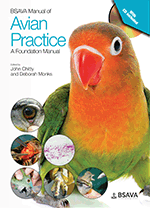
Full text loading...

Handling birds carries a small risk of mortality, particularly with small or diseased birds or if handling is prolonged; preparation and knowledge of handling techniques are essential to mitigating this risk. Parrots, raptors and passerines have different anatomical conformations and therefore present different challenges when it comes to handling and transport; this chapter considers each group of birds separately.
Handling and transporting birds, Page 1 of 1
< Previous page | Next page > /docserver/preview/fulltext/10.22233/9781910443323/9781910443323.9-1.gif

Full text loading...













